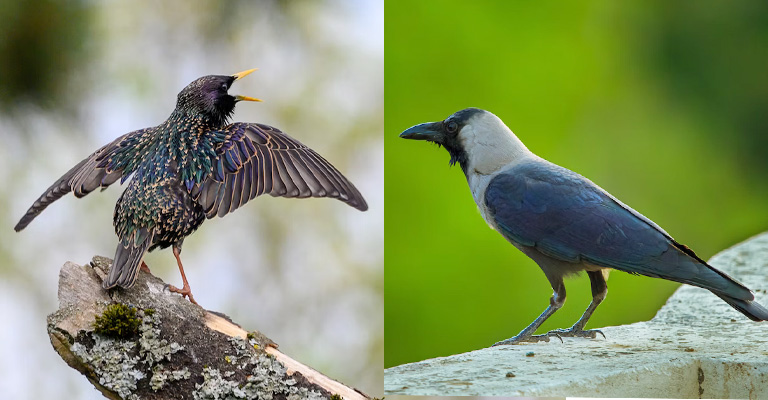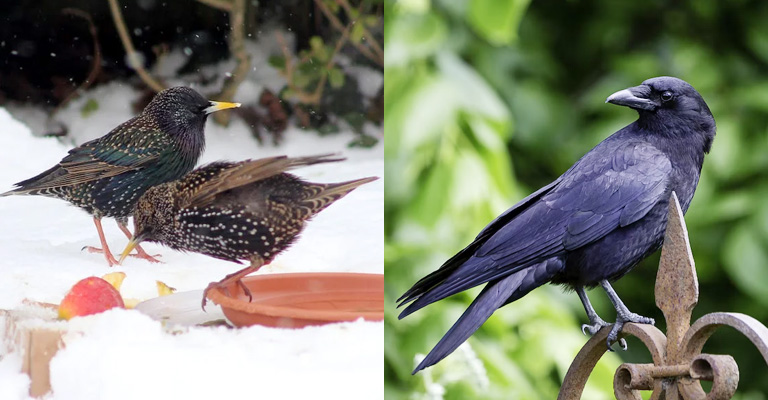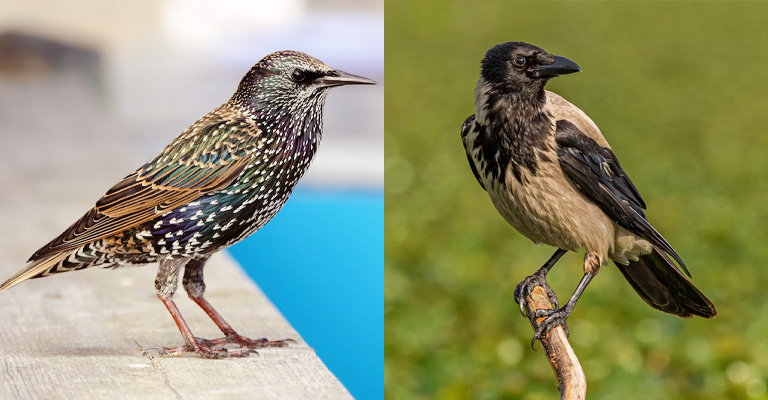When it comes to blackbirds, the starling, and the crow are two species that often capture our attention. With their sleek feathers and intelligent behavior, these avian creatures are known for their adaptability and impressive vocalizations. But how do they compare to each other?
Starlings and crows are different in color, size, and their eating habits. They also have different social interactions, cultural and ecological impacts.
In our Starling vs Crow guide, we will explore the starling and the crow, delving into their characteristics, behaviors, and their impact on the natural world. So, without further ado, let’s dive right in.

Crow VS Starling: A Comparative Study
In a hurry? Check out our detailed comparison table first:
Now, let’s get into a detailed discussion of the differences between Starlings and Crows:
Size and Appearance
When it comes to size, starlings, and crows fall into different categories. Starlings, belonging to the Sturnus genus, are small to medium-sized birds, measuring around 7 to 9 inches in length.
On the other hand, crows, which belong to the Corvus genus, are larger birds, ranging from 16 to 20 inches in length. In terms of appearance, both species sport black feathers, but there are distinct differences in their features.
Bill Color and Leg Color

One way to distinguish between starlings and crows is by examining their bill and leg color. Starlings possess a sharp and slender bill, which is yellow during the breeding season and turns black during the rest of the year.
Their legs are pinkish-gray. In contrast, crows have a stout and robust bill that is entirely black. Similarly, their legs are also black.
Vocalization
Both starlings and crows are known for their vocal abilities, albeit in different ways. Starlings have remarkable vocal mimicry skills and can imitate various sounds they encounter in their surroundings.
They can replicate the calls of other birds, as well as mimic human speech and even sounds produced by machines. On the other hand, crows produce distinct, loud cawing sounds, which serve as territorial calls and means of communication within their groups.
Dietary Habits
Starlings and crows have diverse dietary preferences. Starlings are omnivores, feeding on a wide range of food sources. Their diet includes fruits, berries, insects, seeds, and even small vertebrates.
Crows, too, are omnivorous and display opportunistic feeding behavior. They consume fruits, nuts, seeds, insects, small animals, carrion, and other available food items. This adaptability in their feeding habits contributes to their success in various environments.
Social Structure

In terms of social structure, starlings and crows exhibit different behaviors. Starlings are highly social birds, often seen gathering in large flocks, sometimes numbering in the thousands. They engage in intricate flocking behavior known as ‘murmurations’, where they fly in synchronized patterns, creating mesmerizing displays in the sky.
Crows, on the other hand, live in family groups and exhibit a hierarchical structure within their communities. They also engage in communal roosting, where large numbers of crows gather to rest and communicate.
Adaptability
Both starlings and crows are remarkably adaptable birds, capable of thriving in various environments. Starlings have a cosmopolitan distribution, occupying habitats ranging from urban areas to farmlands and woodlands.
They have even been introduced to other parts of the world, such as North America, where they have become invasive species. Crows, too, display adaptability and can be found in diverse settings, including urban environments, rural landscapes, and forests.
Ecological Impact
Starlings and crows have significant ecological impacts in their respective habitats. They both play crucial roles in seed dispersal, aiding in the maintenance of plant diversity.
Additionally, their feeding habits contribute to the control of insect populations, which can be beneficial for agricultural areas. However, the adaptability and opportunistic nature of starlings and crows can also lead to conflicts with humans, especially in urban areas, where they may cause disturbances or damage crops.
Cultural Significance

Both starlings and crows have cultural significance in various societies and folklore. Starlings have been celebrated for their beautiful murmurations, which captivate observers with their synchronized movements in the sky. They have also been associated with communication and mimicry.
Crows, on the other hand, have often been symbolically linked to death, mystery, and the macabre. They have appeared in myths, literature, and artistic representations throughout history, often portrayed as intelligent and cunning creatures.
Human Interactions
In a broader sense, human interactions with starlings and crows can be both positive and negative. On the positive side, their presence can bring joy and awe through their stunning displays and intelligent behaviors. However, conflicts can arise when these birds cause disturbances in urban areas or damage crops in agricultural settings.
In some regions, efforts are made to manage starling populations to mitigate their impact on native species. It is important to strike a balance between appreciating these birds and addressing the challenges they pose in human-dominated landscapes.
Starling Vs Crow: Comparison Table
Here are some important facts on Starling vs Crow-
| Difference | European Starlings | American Crows |
| Size | Smaller (7-9 inches) | Larger (16-20 inches) |
| Coloration | Iridescent black feathers with shades of green and purple | Entirely black plumage |
| Bill Color | Yellow | Black |
| Leg Color | Pink | Black |
| Vocalization | Mimics various sounds, including other bird species and human speech | Distinctive cawing sound |
| Social Structure | Gregarious, forms large flocks | Pairs or small groups |
| Adaptability | Found in urban areas, farmlands, woodlands | Found in forests, agricultural areas, suburban environments |
| Ecological Impact | May compete with native bird species and can cause damage to agricultural crops | Scavengers, help clean up carrion and maintain ecosystem health |
| Cultural Significance | Associated with communication, storytelling, and magical qualities in folklore | Associated with wisdom, transformation, and messengers between realms in mythology |
| Human Interactions | Methods for deterring from certain areas, considerations for conservation | Methods for deterring from certain areas, considerations for conservation |
Crow vs Starling: Fight Instinct
A fight between a crow and a starling would typically be an encounter between two bird species. Here’s some information about each species and how they might fare in a fight:
Crow:
- Crows are highly intelligent and adaptable birds known for their problem-solving abilities.
- They are larger than starlings, with a wingspan of about 39 inches (100 cm) and a weight of around 1.5 pounds (0.7 kg).
- Crows have strong beaks and sharp talons that they can use for defense.
- They are generally aggressive and territorial, and they often form social groups or families known as “murders.”
- Crows are known to mob and harass larger birds or animals to protect their territory or food sources.
Starling:
- Starlings are medium-sized birds with a length of about 7.5-8.5 inches (19-22 cm) and a weight of around 2-3 ounces (60-85 grams).
- They have sleek black feathers with iridescent purple or greenish hues.
- Starlings are highly social birds that form large flocks and are known for their complex and synchronized flight patterns.
- While they may not possess the physical strength or aggression of crows, starlings can be agile and quick in flight, which could give them an advantage in certain situations.
In a direct fight between a crow and a starling, the outcome would likely depend on various factors such as the size and condition of each individual bird, the context of the encounter, and their respective motivations.
Crows are generally more aggressive and territorial, so they might initiate an attack on a starling if they perceive it as a threat to their territory or food source. However, starlings, with their agility and ability to fly in large flocks, might be able to evade or confuse a crow during an altercation.
FAQ
Crows are predominantly black with a glossy sheen, while starlings have iridescent plumage displaying colors like green, purple, and bronze.
Yes, crows are generally larger, measuring around 16 to 20 inches in length, while starlings are smaller, measuring about 7 to 9 inches in length.
Crows have a stocky build, squared-off tails, and broad, rounded wings. Starlings have a sleeker appearance, tapered tails, and long, pointed wings.
Crows are omnivorous, consuming insects, small vertebrates, fruits, seeds, grains, and carrion. Starlings are primarily insectivorous but also eat fruits, berries, and seeds.
Crows are adaptable and can be found in various habitats, including forests, fields, urban areas, and parks. Starlings prefer open habitats like grasslands, meadows, and urban areas, often forming large flocks.
Wrapping Up!
That was all about Starling vs Crow comparison. starlings and crows are fascinating birds with unique characteristics and behaviors.
From their size and appearance to their vocalizations, diet, and social structures, there are distinct differences between these avian species. Both starlings and crows exhibit adaptability and have significant ecological impacts.
Furthermore, their cultural significance and interactions with humans add to their intrigue. Understanding and appreciating these birds can foster a better coexistence between humans and the natural world they inhabit.